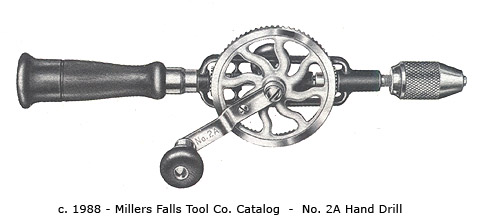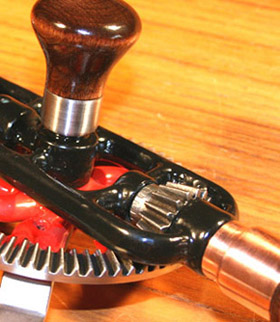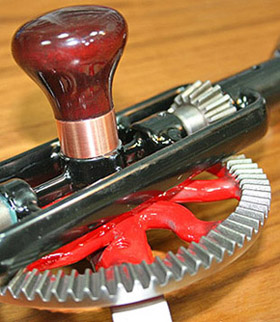|
|
|
|
|
|
|
|
Millers
Falls Hand Drill No. 2A
Transitional
by Wiktor Kuc |
 1 of 10
1 of 10
 |
|
|
|
The hand drill No. 2A was introduced by Millers Falls Company
around 1957.(1) My
collection of catalogs does not go beyond 1949, consequently the
description of this drill is based on data from
the catalog
released by Millers Falls Tool Co., an entity organized in 1982.
The Ingersoll-Rand Company, the owner of Millers Falls Company
prior to 1982, sold all hand tool business to this new entity.
The description and image below is from the catalog published by this new
organization - a Millers Falls Tool Co.
Hand Drill No. 2A:
"Sturdy iron frame and machine cut gear with 4-1/2 : 1 gear
ratio. Hollow hardwood handle holds eight drill points:
1/16 to 11/64 included with tool. Main and side handles
made in tropical hardwood, stained and lacquered.
Side handle is detachable. Ball thrust bearing on spindle;
three-jaw, spring chuck adjustable from 0 to 3/8 inch.
Frame is enameled black and drive gear enameled red.
Bright parts are nickel plated."

Data Summary:
| Model
No. |
Design Type |
Frame
Bearing |
Chuck
|
Paint |
Handles
|
Length
Weight |
Standard Equip. |
Prod.
Dates |
|
2A |
2
pinion
1 speed |
Die-cast alloy
One Ball Bearing |
3-jaw, spring
0 - 3/8 inch |
Frame - Black
Gear - Red |
Stained Hardwood |
14 1/5"
2 1/5 lb. |
8
drill bits |
1957
1968 |
I have been fortuned to handle and examine in detail
many samples of MF Hand Drill No. 2A. In majority
of cases the drills look just as the one seen below.
Some later production batches included drills with tigerwood handle, covered with
reddish lacquer.

Major differences between this 1957 model and preceding 1938
edition are in the type of metal used for the frame, casting
method of the frame, the size and appearance of the frame,
and the spindle diameter.
|
The No. 2 drill released in 1938 and produced until 1957, (the
introduction year of No. 2A) is made of malleable cast
iron later machined to affect a few areas of the
frame.
The No. 2A drill was built differently. The unspoken truth
is that the 1957 model is not build of iron. The metal used was
an alloy, popularly know as "Pot Metal" or "White Metal".
The above catalog description or any other source known to me
conveniently avoids this subject. There is no record that
I know of describing precisely and identifying the type of metal
used by Millers Falls to produce No. 2A drill. For the
sake of clear distinction and to establish clear terminology I
presume
that the alloy used was
standardized "Zamak".
The casting was done in a die and this, in
combination with properties of ZAMAK, produced highly
accurate shape of the drill frame.
|
|
|
POT METAL AND ZAMAK Pot
metal, also known as white metal, die-cast
zinc, or monkey metal, is a slang term that
refers to alloys that consist of
inexpensive, low-melting point metals used
to make fast, inexpensive castings. There is
no scientific metallurgical standard for pot
metal; common metals in pot metal include
zinc, lead, copper, tin, magnesium,
aluminum, iron, and cadmium.
WIKIPEDIA
Zamak (formerly trademarked as ZAMAK[1] and
also known as Zamac) is a family of alloys
with a base metal of zinc and alloying
elements of aluminum, magnesium and copper.
Zamak alloys are part of the zinc aluminum
alloy family; they are distinguished from
the other ZA alloys because of their
constant 4% aluminum composition.[2]
The
name zamak is an acronym of the German names
for the metals of which the alloys are
composed: zink (zinc), aluminum, magnesium
and kupfer (copper).[2] The New Jersey Zinc
Company developed zamak alloys in 1929.
While zinc alloys are popularly referred to
as pot metal or white metal, zamak is held
to higher standards.
WIKIPEDIA |
|
|
|
|
|
|

The No. 2-1938 frame. The width of the outside beam is
0.3 inch. |
|

The No. 2A-1957 frame. The width of the outside beam is
0.5 inch. |
The appearance of the frame changed in comparison to the No.2
-1938 model. The outside beams of the
frame are much wider then in 1938 edition (see comparison images
above). I believe this change was introduce to compensate
for lower strength of the "pot metal" and the need to make frame
more sturdy.
(1). Millers Falls Home Page -
Website
of Randy Roeder |
|
|
|
|
 1 of 10
1 of 10
 |
|
|
|